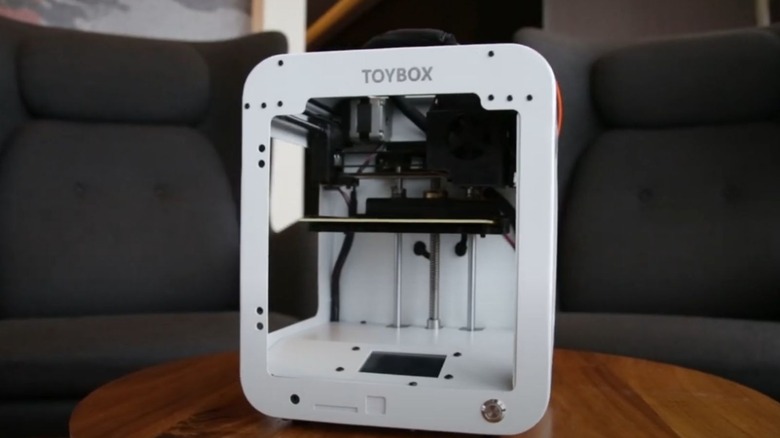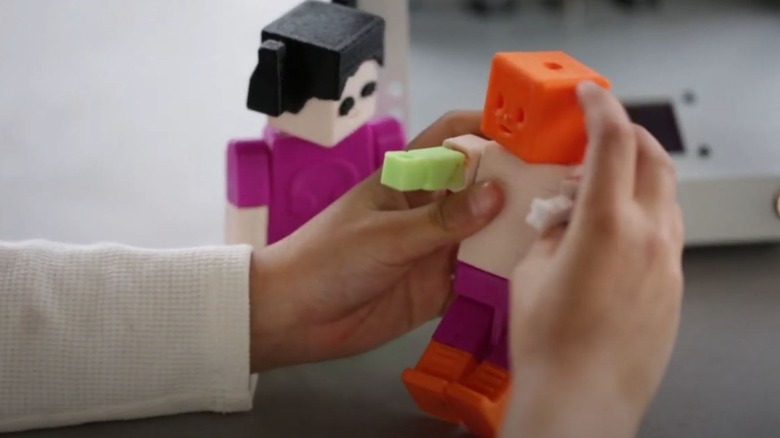What Happened To The Toybox 3D Printer From Shark Tank Season 10?
Could something as advanced and as costly as 3D printing be diluted into a child-friendly toy? That was the question Jenn Chin and Ben Baltes, former Microsoft engineers-turned-entrepreneurs, aimed to answer with ToyBox. Taking already available technology — similar to the Creatbot Super Mini — Chin and Baltes fashioned a printer they felt would be perfect for six- to nine-year-olds. Even before entering the tank, though, the team received a small dose of reality.
Premiering at the 2016 San Francisco Maker Faire, Toybox had a shaky start. Children were interested in the prototype, and the team printed hundreds of toys that weekend. However, they faced the challenge of having to make product look sleeker and find the right price point. One of those proved to continue to be an issue on "Shark Tank," though not staggering enough to sink Chin and Baltes' chances of securing a deal completely.
As the duo stepped into the tank, at least one Shark circled, exploring what taking a bite of this clever idea would bring.
What Happened to The Toybox 3D Printer on Shark Tank?
As Chin and Baltes entered the tank, Mark Cuban, Daymond John, Kevin O'Leary, Lori Grenier, and guest judge, Wi-Fi video doorbell pioneer and future judge on Amazon's "Buy It Now" Jamie Siminoff, waited. The duo started with an ask for $150,000 for 5% of their company (a $3 million valuation) and a chance to work with them on this "first of its kind" 3D printer and platform for kids.
After passing around toy samples, Baltes explained the initial startup cost of $290,000. Lori was the first to speak up with the most pertinent question: Is it cheaper than the then-current 3D printer models? While the $300 price tag is definitely more appealing than the $400 start in 2016, Siminoff wasn't too keen on it, calling it a "big decision on a toy" despite the integration of 3D printing hardware and software into one consumer-friendly device.
Despite trying to sweeten the pot with the idea of licensed IPs, Chin and Baltes couldn't attract every Shark. Cuban dropped first, citing the hours-long process of printing. John was next, fearing liability and safety issues, while Siminoff harped on the price. O'Leary then jumped in with an offer: $150,000 for 10%. Unfortunately, the entrepreneurs awaited Grenier's feedback, only for her to bow out, giving O'Leary a chance to up his ask to 12%. Eventually, a deal was made for $150,000 for 13% and an additional 2% in advisory shares.
The Toybox 3D Printer After Shark Tank
Even before Toybox was featured on "Shark Tank," the company had a very active social media presence and was still selling its 3D printers. In fact, it was enough of an appealing design that, in November 2018, they announced that a scam website was posing as a Toybox retailer to steal money from consumers. That's one sign that a company is making a big splash, and it only seemed to get bigger after the March 2019 "Shark Tank" episode aired.
Within two months of the episode airing, Toybox announced new developer job openings as it sought to expand its team. Just as Chin and Baltes suggested on the "Shark Tank" floor, licensing eventually became part of the Toybox 3D printing ecosystem. In 2020, the company secured a license to produce "Dennis and Gnasher: Unleashed!" print files for the U.K.-based Beano Studios. Additional publishers like Warner Bros., Illumination, and Universal Studios also signed on in the years following Toybox's "Shark Tank" appearance, with well-known characters like SpongeBob Squarepants and Batman.
While O'Leary didn't seem to hesitate to offer to join Toybox, the absence of the company's logo on his official listing of "Shark Tank" investments on his website suggests the deal was never finalized. Clearly, that hasn't stopped the company's innovation, especially as it launched a monthly membership for exclusive discounts and prints that was first mentioned on its social media in November 2022.
Is The Toybox 3D Printer Still in Business?
As of December 2024, Toybox is still in business. There's nothing to suggest that it is slowing down, either. Though its Instagram, YouTube, TikTok, and Twitter accounts have gone quiet, it remains rather active on Facebook with new product announcements, sales, and more. The company also entered into a new celebrity license agreement with magicians Penn & Teller in mid-2024 to produce at-home magic trick files that can be printed by the Toybox 3D printer. At the time of the announcement, COO Malcolm Bird stated that there were more than 250,000 registered users on the Toybox platform, with toys being printed at an average rate of one every 3.1 seconds.
Additionally, according to their LinkedIn profiles, both Jenn Chin and Ben Baltes are still associated with Toybox Labs. Other team members like third cofounder Zach Oligschlaeger, 3D designer and sculptor Michael Balzano, content head Michael Pedersen, and toy designer Elexis King still list Toybox as their current (and only) employer.
What's Next for The Toybox 3D Printer?
While Chin and Baltes were quite insistent on having children print "Minecraft" worlds using the Toybox 3D printer, that's yet to become a reality. There are "Minecraft"-themed prints available in the Toybox library, but they're user-created models, unlike, say, the "Jurassic Park" 8-Bit Park Gate credited to Amblin Entertainment. As the device and its continuously growing library of print files continue to appeal to consumers, the expansion of its product lineup and available license agreements are the two primary avenues for an even brighter future.
With a growing market full of 3D printers made for different applications, Toybox has to fight to keep its place as a 3D printing alternative made specifically for children. This is especially true as others may creep into its space, like the handheld 3Doodler pen that allows children to make freehand 3D creations or the cheaper Entina mini 3D printer geared toward beginners. One way is through the expansion of its product line, as it's doing with the Toybox Comet. Available for pre-order for a spring 2025 release, the Comet is a bigger unit than the original Toybox, capable of a significantly larger build volume and faster print speeds.
The company also continues to produce new spools of Printer Food, or the colorful filament used to bring designs to life. The last Printer Food release was back in March 2023, so Toybox is certainly due for some new colors and styles.




